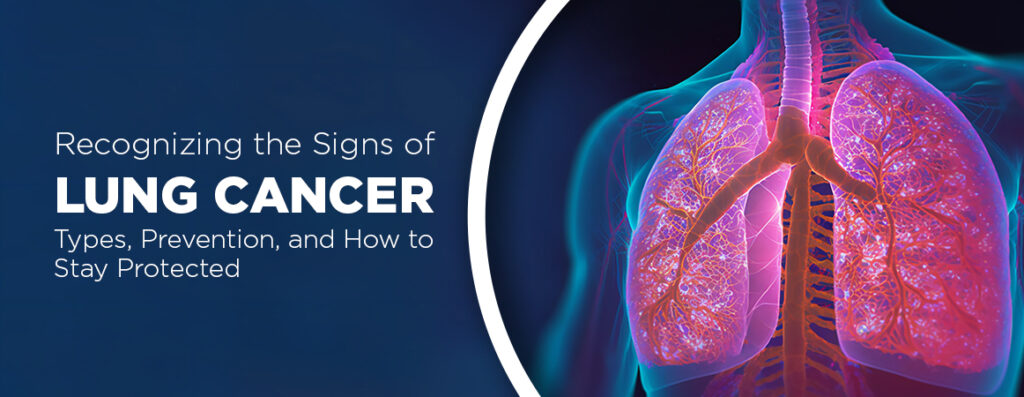Recognizing the Signs of Lung Cancer, Types, Prevention, and How to Stay Protected
Lung cancer is a serious health concern that often goes undetected until it has progressed to an advanced stage. Awareness of its symptoms, types, and prevention strategies is crucial for early detection and effective treatment.
Types of Lung Cancer
There are two primary types of lung cancer, and they differ in how they grow and spread:
- Non-Small Cell Lung Cancer (NSCLC)
NSCLC is the most common type of lung cancer, accounting for about 85% of cases. It generally grows and spreads more slowly than other types of lung cancer. NSCLC has three main subtypes:
- Adenocarcinoma: This is the most common form of NSCLC and usually occurs in smokers or former smokers but is also the most common type in non-smokers.
- Squamous Cell Carcinoma: Often found in the central parts of the lungs, this type is more common in smokers.
- Large Cell Carcinoma: This type can appear in any part of the lung and tends to grow quickly.
- Small Cell Lung Cancer (SCLC)
SCLC, also known as oat cell cancer, accounts for about 10-15% of all lung cancers. It grows more rapidly and tends to spread to other parts of the body more quickly than NSCLC. SCLC is almost always associated with smoking.
Common Symptoms of Lung Cancer
Being aware of the symptoms can save lives, as early detection is critical for treatment success. Some of the common signs and symptoms include:
- Persistent Cough: A cough that doesn’t go away or worsens over time.
- Chest Pain: Pain that is sharp or persistent, especially when coughing or breathing deeply.
- Shortness of Breath: Difficulty breathing even during mild activities.
- Unexplained Weight Loss: Sudden, unintended weight loss.
- Fatigue: Ongoing tiredness and lack of energy.
- Wheezing: A whistling sound when breathing.
- Recurrent Respiratory Infections: Frequent cases of bronchitis or pneumonia.
Lung Cancer Prevention
While not all cases of lung cancer can be prevented, there are steps you can take to significantly lower your risk:
1) Quit Smoking
The leading cause of lung cancer is smoking. Quitting smoking at any age reduces the risk of lung cancer, and it’s never too late to stop.
2) Avoid Secondhand Smoke
Exposure to secondhand smoke also increases the risk of lung cancer. Make your home and environment smoke-free.
3) Test Your Home for Radon
Radon exposure is a leading cause of lung cancer in non-smokers. Testing your home for radon can help prevent this exposure.
4) Limit Exposure to Carcinogens
If you work in an environment with harmful substances like asbestos, ensure that you follow safety protocols to limit exposure. Wear protective gear and follow workplace guidelines.
5) Eat a Healthy Diet
A diet rich in fruits and vegetables can support lung health. Antioxidants and nutrients in these foods may lower cancer risk.
6) Exercise Regularly
Physical activity helps improve lung function and overall health, reducing the risk of many types of cancer.
Conclusion
At MMI Hospital, we are dedicated to raising awareness about lung cancer and promoting prevention, early detection, and effective treatment. Whether you need guidance on symptoms, risk factors, or preventive measures, we encourage you to consult with our healthcare professionals. Together, we can fight lung cancer and support a healthier future. Stay informed, stay vigilant, and stay protected.
Post Disclaimer
The information contained in this post is for general information purposes only. The information is provided by "Recognizing the Signs of Lung Cancer, Types, Prevention, and How to Stay Protected "and while we endeavour to keep the information up to date.
Legal Disclaimer
We do not claim to cure any disease which is considered’ incurable ‘ on the basis of scientific facts by modern medicine .The website’s content is not a substitute for direct, personal, professional medical care and diagnosis. None of the medicines mentioned in the posts ,including services mentioned at "medicineguide.us" should be used without clearance from your physician or health care provider.
Testimonials Disclaimer– : Results may vary, and testimonials are not claimed to represent typical results. The testimonials are real, and these patients have been treated with homeopathy treatment from our clinic . However, these results are meant as a showcase of what the best, Medicine can do with their disease contions and should not be taken as average or typical results.


